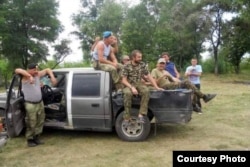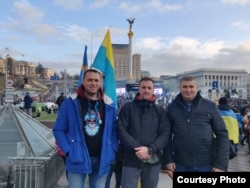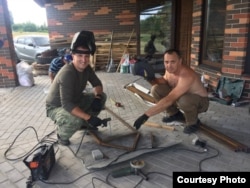Ukraine's war against Russia did not begin in the early hours of February 24, 2022, when tens of thousands of Russian troops crossed into the country in a massive, unprovoked act of aggression. For Ukrainians, their country started out on the perilous path of resistance to Russia on November 21, 2013.
That was the day protests broke out on Kyiv's Maidan Nezalezhnosti -- Independence Square -- after President Viktor Yanukovych unexpectedly bowed to pressure from Moscow and rejected a completed Association Agreement with the European Union.
Within days, a massive protest encampment had cropped up in the center of the capital. Protesters refused to go home, occupying the square around the clock even as the winter came on. Despite the constant threat of attack by echelons of riot police and occasional clashes with security forces, the protesters organized lectures and performances. With the support of the entire country, they set up kitchens, first-aid posts, and their own defense militias.
The events of those times changed the lives of millions of Ukrainians, fostering for many a vision of the future that motivates them to the present day.
'Standing Firm'
Oleksandr Kolotvin was a 28-year-old chef in the Dnipropetrovsk region town of Pyatykhatky when the Maidan events erupted. He immediately made the decision to travel to Kyiv, telling his fiancée that he needed to "live alone for a while," his mother, Nadia Kolotvina, told RFE/RL.
"He was working three days on and three days off at the time," she recalled. "And on his days off, he left for the Maidan in Kyiv. He didn't even tell us at first."
Kolotvina said she tried to talk him out of participating, urging him to return home. "'Everything is fine here,'" she recalled him telling her. "'We are standing firm.'"
The tense events came to a climax on February 18-20, 2014, when sniper fire and fierce fighting between government forces and the protesters left about 100 demonstrators and 13 police dead. Within days, Yanukovych and most of his government had fled to Russia. Moscow engineered the occupation of Ukraine's Crimea region and fomented a deadly separatist conflict in parts of two eastern regions.
Kolotvin volunteered for the Aidar Battalion in May 2014, taking the nom de guerre Sakha. He left without saying anything to his mother.
"My daughter came to me and said, 'Mama, sit down and don't worry,'" Kolotvina said. "'Our Sasha has gone to the war.'"
By June, Kolotvin was in the combat zone, participating in Ukraine's "anti-terrorism operation" against Russian forces and Russia-backed militants in the area around the Luhansk airport.
Kolotvina spoke with her son several times in late July and early August. She tried to convince him to come home, but he was determined. "'I can't abandon the others,'" she remembers him telling her. "'I can't let my comrades down. If not me, then who?'"
Okeksandr Kolotvin was killed in the Luhansk region on August 13, 2014, when his armored personnel carrier was struck by enemy fire. Several days passed before his body was recovered.
"They were lying in a field under the sunflowers," Kolotvina said. He was 29 years old and had spent a little less than three months in combat.
'We Go Together To The Cemetery'
Denys Havryushyn was a lawyer in the eastern city of Dnipro. His former teacher and close family friend, Lyudmyla Kostryukova, recalls him as a thoughtful and lively student who loved reading and yoga.
He first became actively interested in politics during the events of the 2004 Orange Revolution.
In the fall of 2013, Kostryukova ran into her former student among the protesters on Kyiv's Maidan.
"I was so happy to see my former students on the Maidan in 2013," she said. "Denys was in the middle of the crowd with his friend."
"The last time I saw him was when we were standing outside the regional administration building [in Dnipro, which until 2016 was called Dnipropetrovsk]," she said.
"There was a rumor the titushky were going to take it over," she explained, using the informal word for pro-Russian thugs who often acted as provocateurs at that time. "So we and other Maidan people were there and Denys and his friends were too."
Immediately after the February 2014 events, when a so-called "Russian Spring" -- to use the Kremlin's euphemism for its efforts to foment separatism in Ukraine -- was threatening the Dnipropetrovsk region as well as those further east, Havryushyn and many other local men signed up for the army. He ended up with the 25th Paratroop Brigade and saw some of the fiercest combat in the Donetsk region – Slovyansk, Kramatorsk, Debaltseve.
He was killed on August 17, 2014, when the vehicle he was travelling in was hit by rocket fire. He was 30 years old.
"I grieved for him as if he was my own," Kostryukova said. "At his funeral, I met his mother.... Now we are not just friends, but relations. Every year we go together to the cemetery on Denys's birthday and on the day that he died. He was a person with a heightened sense of justice and respect for human dignity. If he was alive, I think he'd be a leading figure in Ukraine now."
'We Had To Stand Up And Demand Change'
Before Maidan, Denys Kosenko was a successful entrepreneur with several businesses in Dnipropetrovsk. His friend, Yevhen Zhyrko, who is currently a soldier, met Kosenko more than 15 years ago. But they became close during the Maidan events, traveling together back and forth to Kyiv to bring supplies to the protest camp.
During this time, Zhyrko said, "we became a single unit."
"We developed a schedule of working in [Dnipropetrovsk] three or four days and then going to Kyiv for several days," he recalled. "That's the way it was through the whole duration of the Maidan [protests]. We brought them groceries, medicine, volunteers. We had a van that could carry seven or eight people."
Zhyrko recalls that one morning he woke up at home to find out there had been violence in Kyiv.
"Den called me immediately and said, 'Well, we have woken up in a different country,'" he said. "I told him, 'That's for sure.'"
They returned to the Maidan.
"We had a dream," Zhyrko explained. "And we were confident we were right and that we could really do something. We didn't have any other choice. We had to stand up and demand change."
After Russia occupied Crimea and the war broke out in parts of eastern Ukraine, Kosenko volunteered to help the troops and repair damaged military equipment. He organized a support group on Facebook and his office became a locus of activity.
"People brought aid there," Zhyrko said. "And vehicles were towed there to be repaired for the military. We repaired about 15 trucks at our own expense."
In 2015, Kosenko was mobilized. He took the nom de guerre Amur and was assigned to the 25th Separate Paratroop Brigade.
"He didn't try to evade service…although he had a large business that needed to be managed," Zhyrko said.
A year later, Kosenko returned home and entered the military reserves. He joined a volunteer group and helped create a summer camp for children.
"He built a home for himself, too, and he and his wife had a third son, Makar," Zhyrko recalled.
Then Russia invaded Ukraine early on the morning of February 24. By 7 a.m. Kosenko was at the recruiting office. He was sent to the Avdiyivka area in the Donetsk region.
"I was in touch with him, but we didn't say much," Zhyrko said. "At first things were quiet, but then serious combat started."
Kosenko was killed in battle near Novobakhmutivka in the Donetsk region in April. He is buried in Dnipro.
Living With The Pain
The eight years since her son was killed have been hard for Nadia Kolotvina. She has devoted her life to contributing as she can to the war effort.
"I head a big volunteer center," she told RFE/RL's Ukrainian Service. "We make clothes for the troops, camouflage nets, and so on. We help children write letters and draw pictures to send to the front…. We take clothes and other goods to hospitals."
Having lost a son herself, Kolotvina devotes particular attention to the families of other slain soldiers.
"We make flags with the portraits of local heroes from Pyatykhatky," she said. "When there is a funeral, I…try to be there, to find words that can support people."
"The price of our freedom has been very great," she said. "But we have to continue living with the pain."
















